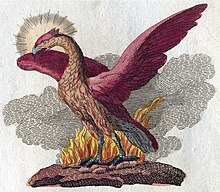A phoenix or phenix (Greek: φοῖνιξ phoinix) is a long-lived bird that is cyclically regenerated or reborn. Associated with the sun, a phoenix obtains new life by arising from the ashes of its predecessor. The phoenix was subsequently adopted as a symbol in early Christianity. In some versions of the legend, the phoenix dies in a show of flames and combustion, although there are other versions in which the legendary bird dies and simply decomposes before being born again. According to some legends, the phoenix could live over 1,400 years before rebirth. Herodotus, Lucan, Pliny the Elder, Pope Clement I, Lactantius, Ovid, and Isidore of Seville are among those who have contributed to the retelling and transmission of the phoenix motif.
In the historical record, the phoenix "could symbolize renewal in general as well as the sun, time, the Empire, metempsychosis, consecration, resurrection, life in the heavenly Paradise, Christ, Mary, virginity, the exceptional man, and certain aspects of Christian life".
Etymology

The modern English noun phoenix derives from Middle English phenix (before 1150), itself from Old English fÄ"nix (around 750). Old English fÄ"nix was borrowed from Medieval Latin phenix, which is derived from Classical Latin phoenÄ«x. The Classical Latin phoenÄ«x represents Greek φοῖνιξ phoinÄ«x.
In ancient Greece and Rome, the bird, φοῖνιξ, was sometimes associated with the similar-sounding Phoenicia, a kingdom famous for its production of purple dye from conch shells. A late antique etymology offered by the 6th- and 7th-century CE archbishop Isidore of Seville accordingly derives the name of the phoenix from its allegedly purple-red hue. Because the costly purple dye from Phoenicia was associated with the upper classes in antiquity and, later, with royalty, in the medieval period the phoenix was considered "the royal bird".
In spite of these folk etymologies, with the deciphering of the Linear B script in the 20th century, the original Greek φοῖνιξ was decisively shown to be derived from Mycenaean Greek po-ni-ke, itself open to a variety of interpretations..
Relation to the Egyptian Bennu

Classical discourse on the subject of the phoenix points to a potential origin of the phoenix in Ancient Egypt. In the 19th century scholastic suspicions appeared to be confirmed by the discovery that Egyptians in Heliopolis had venerated the Bennu, a solar bird observed in some respects to be similar to the Greek phoenix. However, the Egyptian sources regarding the benu are often problematic and open to a variety of interpretations. Some of these sources may have been influenced by Greek notions of the phoenix.
Appearance

The phoenix is sometimes pictured in ancient and medieval literature and medieval art as endowed with a nimbus, which emphasizes the bird's connection with the sun. In the oldest images of phoenixes on record these nimbuses often have seven rays, like Helios (the personified sun of Greek mythology). Pliny also describes the bird as having a crest of feathers on its head, and Ezekiel the Dramatist compared it to a rooster.
Although the phoenix was generally believed to be colorful and vibrant, there is no clear consensus about its coloration. Tacitus claims that its color made it stand out from all other birds. Some thought that the bird had peacock-like coloring, and Herodotus' claim of red and yellow is popular in many versions of the story on record. Ezekiel the Dramatist declared that the phoenix had red legs and striking yellow eyes, but Lactantius said that its eyes were blue like sapphires and that its legs were covered in scales of yellow-gold with rose-colored talons.
In terms of size, R. Van den Broek, Herodotus, Pliny, Solinus, and Philostratus describe the phoenix as similar in size to an eagle, but Lactantius and Ezekiel the Dramatist both claim that the phoenix was larger, with Lactantius declaring that it was even larger than an ostrich.
Analogues
Scholars have observed analogues to the phoenix in a variety of cultures. These analogues include the Arabic anqa, the Hindu garuda and gandaberunda, the Russian firebird, the Persian Simorgh, Georgian paskunji, the Turkish Zümrüdü Anka, the Tibetan Me byi karmo, the Chinese fenghuang and zhu que, and the Japanese hÅ-Å.
See also

- Chol (bible), a Hebrew word sometimes glossed as phoenix
Notes
References

- Barnhart, Robert K (1995), The Barnhart Concise Dictionary of Etymology, HarperCollins, ISBNÂ 0-06-270084-7Â .
- Garry, Jane; El-Shamy, Hasan (2005), Archetypes and Motifs in Folklore and Literature, ME Sharpe, ISBNÂ 978-0-76561260-1Â .
- Van der Broek, R (1972), The Myth of the Phoenix, Seeger, I trans, EJ Brill .
- Lundy, John P. (1876), Monumental Christianity, JW BoutonÂ

